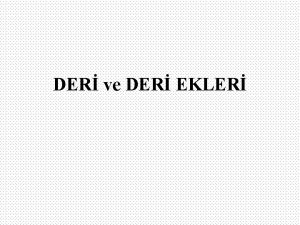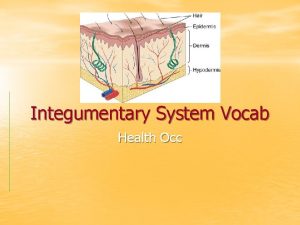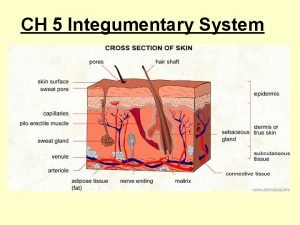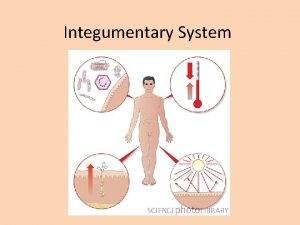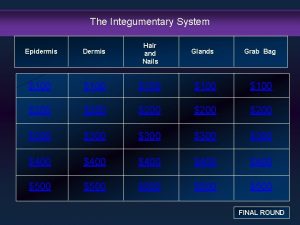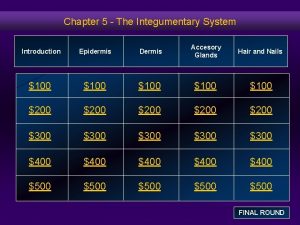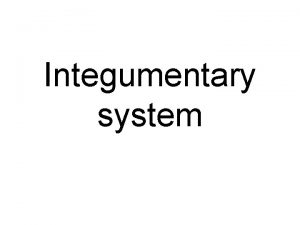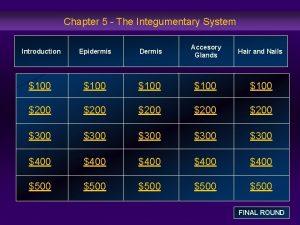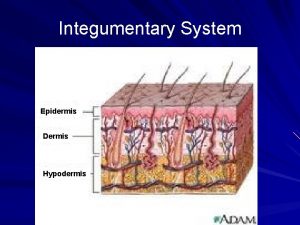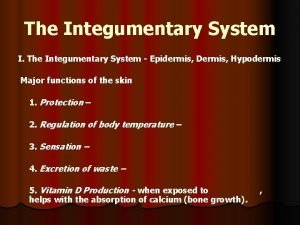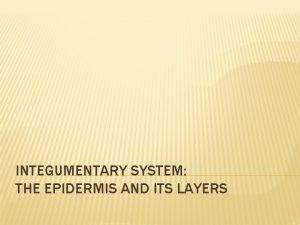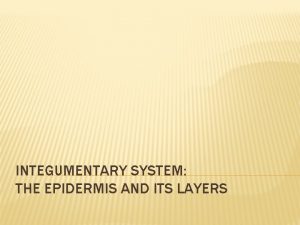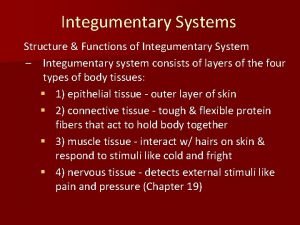Integumentary System 2 Regions 1 Epidermis 2 Dermis














- Slides: 14

Integumentary System 2 Regions: 1. Epidermis 2. Dermis Subcutaneous tissue: 1. below dermis 2. Also called hypodermis 3. Mainly adipose tissue

Skin regions: #1 Epidermis • Avascular • Mostly keratinized epithelium tissue Contains 4 cell types 1. 2. 3. 4. Keratinocytes Melanocytes Epidermal dendritic Tactile

Layers of the Epidermis: 4 layers Deep to superficial: 1. Stratum Basale 1. Stratum Spinosum 1. Stratum Granulosum 1. Stratum Corneum

Epidermis Layer #1: Stratum Basale • Single row of cells • Next to dermis Cell type: melanocytes or very early keratinocyte • Consistently dividing • “spidery-pigmented” • Resembles cardboard

Epidermis layer #2: Stratum Spinosum • Several cell layers thick • Cell division occurs but not as much as Basale • Basale & Spinosum only layers of epidermis to receive nutrition • Keratinocytes look “spikey”

Epidermis layer #3: Stratum Granulosum • 3 -5 cell layers thick • Keratinization starting to occur • Cells start to flatten & loss of nucleus & organelles • Accumulate granules that secrete: - glycolipid - keratin

Epidermis layer #4: Stratum Corneum • 75% of epidermis • 20 -30 cell layers thick • Cells are dead • Consistently are replaced by lower layer • Filled with keratin, flat shaped

Dermis: Layer #1 Papillary Layer • Finger like projections • Attaches to epidermis • Mainly connective tissue

Dermis layer #2 : Reticular Layer (80 %) Contains: 1. Blood vessels 3. Sweat Glands 2. Sebaceous glands 4. Pressure Receptors * Rich blood supply helps with body temp control

Appendages of the Skin: Sweat Glands Sebaceous Glands Hair follicles

Sweat Glands: Sudoriferous Glands Two Types: 1. Eccrine: merocrine • most numerous • Palms , soles, forehead • Coiled gland, tubular gland • Secretory part in dermis

Sweat Glands: Sudoriferous Glands 2. Apocrine Glands: • Larger than eccrine glands • Lie deeper in dermis • Empty secretions into hair follicles

Sebaceous Glands: oil glands • Found all over body • Small on trunk, large on face, neck and chest • Secrete sebum • Secreted into hair follicle or directly on skin surface • Hormone induced

Hair Follicles: Structures of hair follicles: • Bulb • Plexus • Arrector pili • Papilla
 Integumentary system the integument epidermis coloring page
Integumentary system the integument epidermis coloring page Derinin ekleri
Derinin ekleri Uneven junction of the dermis with the epidermis
Uneven junction of the dermis with the epidermis Cutaneous membrane
Cutaneous membrane Integumentary system vocabulary
Integumentary system vocabulary Fetal pig integumentary system
Fetal pig integumentary system Integument adalah
Integument adalah Epidermis layers
Epidermis layers The integumentary system exercise 7
The integumentary system exercise 7 Integumentary system vocabulary
Integumentary system vocabulary Exfoliative dermatitis
Exfoliative dermatitis Integumentary system
Integumentary system Integumentary system assessment
Integumentary system assessment Excretory system analogy
Excretory system analogy The integumentary system
The integumentary system

